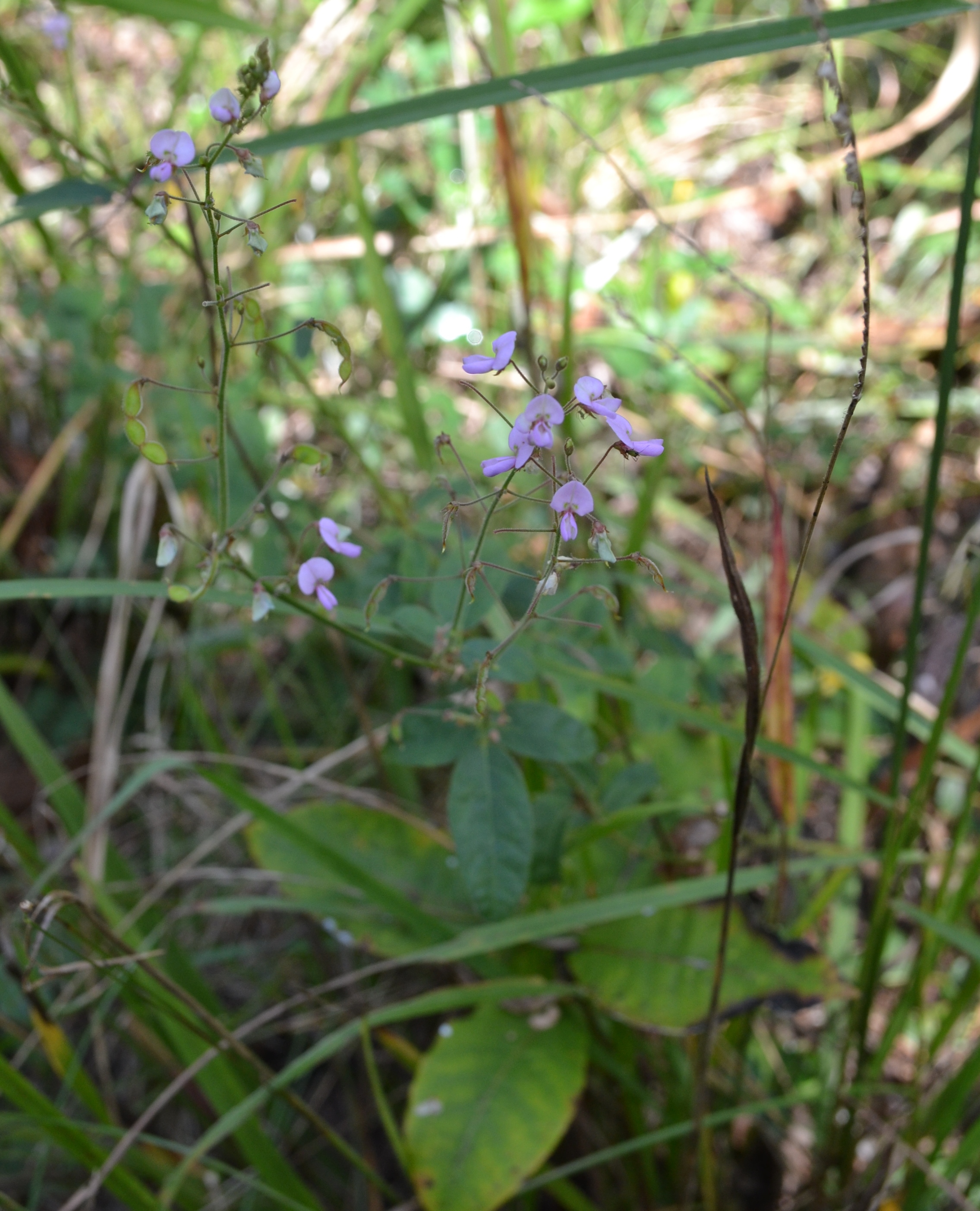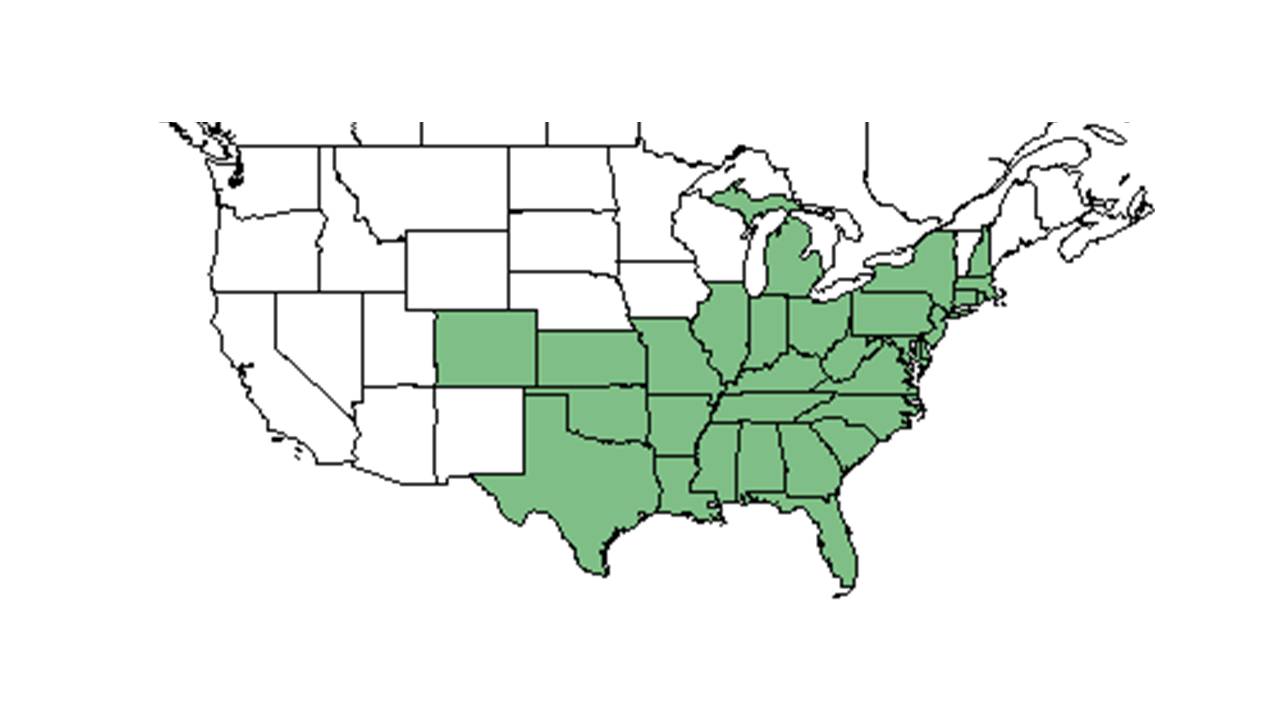Difference between revisions of "Desmodium obtusum"
(→Seed dispersal) |
|||
| Line 18: | Line 18: | ||
}} | }} | ||
| − | Common name: Stiff | + | Common name: Stiff Tick-trefoil |
==Taxonomic notes== | ==Taxonomic notes== | ||
Synonyms; ''Desmodium rigidum'' (Elliott) A.P. de Candolle; ''Meibomia rigida'' (Elliott) Kuntze | Synonyms; ''Desmodium rigidum'' (Elliott) A.P. de Candolle; ''Meibomia rigida'' (Elliott) Kuntze | ||
Revision as of 14:22, 26 April 2019
| Desmodium obtusum | |
|---|---|

| |
| Photo taken by Kevin Robertson | |
| Scientific classification | |
| Kingdom: | Plantae |
| Division: | Magnoliophyta - Flowering plants |
| Class: | Magnoliopsida – Dicotyledons |
| Order: | Fabales |
| Family: | Fabaceae ⁄ Leguminosae |
| Genus: | Desmodium |
| Species: | D. obtusum |
| Binomial name | |
| Desmodium obtusum (Muhl. ex Willd.) DC. | |

| |
| Natural range of Desmodium obtusum from USDA NRCS Plants Database. | |
Common name: Stiff Tick-trefoil
Contents
Taxonomic notes
Synonyms; Desmodium rigidum (Elliott) A.P. de Candolle; Meibomia rigida (Elliott) Kuntze
Description
Generally, for Desmodium genus, they are "annual or perennial herbs, shrubs or small trees. Leaves 1-5 foliolate, pinnately 3-foliolate in ours or rarely the uppermost or lowermost 1-foliolate; leaflets entire, usually stipellate; stipules caduceus to persistent, ovate to subulate, foliaceous to setaceous, often striate. Inflorescence terminal and from the upper axils, paniculate or occasionally racemose; pedicel of each papilionaceous flower subtended by a secondary bract or bractlet, the cluster of 1-few flowers subtended by a primary bract. Calyx slightly to conspicuously 2-lipped, the upper lip scarcely bifid, the lower lip 3-dentate; petals pink, roseate, purple, bluish or white; stamens monadelphous or more commonly diadelphous and then 9 and 1. Legume a stipitate loment, the segments 2-many or rarely solitary, usually flattened and densely uncinated-pubescent, separating into 1-seeded, indehiscent segments." [1]
Specfically, for D. obtusum species, they are "erect perennial; stems 0.5-1.2 m tall, densely uncinate-pubescent. Terminal leaflets oblong to ovate or elliptic, (0.8) 2-3.5 (4.5) cm long, mostly 1,8-2.2 times as wide, short-puberulent to short-pubescent or glabrate above, sparsely to densely short-pubescent and reticulate below; stipules soon deciduous, lance-attenuate to ovate-lanceolate, 2-6 mm long; stipels persistent. Inflorescence usually paniculate, short-pubescent to pilose; petals purplish, ca. 4-6 mm long; stamens diadelphous. Loment of 1-4 weakly obovate to suborbicular segments, each 3-5 mm long, 2.5-2.5 mm broad, very slightly convex along the upper suture and broadly rounded below, densely uncinulate-puberulent on both sides and sutures; stipe about 1.5-3.5 mm long, longer than the calyx tube but shorter than the lobes and the stamina remnants." [1]
Distribution
Found north to New Hampshire south to Florida and west to Colorado.[2]
Ecology
Habitat
It is distributed widely throughout the eastern U.S. and southern Great Plains.[3] Occurs in frequently burned longleaf and shortleaf pine-oak-hickory upland native and old-field communities (Ultisols),[4][5] longleaf pine-turkey oak sandhills (Entisols), longleaf and slash pine flatwoods (Spodosols), and in limestone outcrops.[5] It is fire-tolerant.[4] Occurs in both native areas and areas with recent soil disturbance. Some seem to have ruderal-growing tendencies. Occurs on a wide range of soils from loamy sand to clayey soils; and in sites ranging from xeric to moist. Associated species include Desmodium glabellum and Gnaphalium obtusifolium.[5]
Phenology
In the southeastern coastal plain it flowers from September to October and fruits from September to November.[5]
Seed dispersal
This species is thought to be dispersed by translocation on animal fur or feathers. [6]
Fire ecology
It thrives in frequently burned (1-2 year interval) habitats and occurs primarily in high-light environments but can also tolerate partial shade.[5]
Pollination
Floral visitors include bumblebees (Bombus), longhorned bees (Melissodes spp.), and leaf cutter bees (Megachile spp.).[7]
Use by animals
Insect feeders include skipper caterpillars as Achalarus lyciades (Hoary Edge), Thorybes bathyllus (Southern Cloudywing), Thorybes pylades(Northern Cloudywing), and Epargyreus clarus (Silver-Spotted Skipper); the caterpillars of the butterflies Everes comyntas(Eastern Tailed Blue) and Strymon melinus (Gray Hairstreak). Seeds are eaten by gamebirds (Bobwhite, Wild Turkey) and rodents (White-Footed Mouse, Deer Mouse). White-Tailed Deer and Cottontail Rabbits eat the foliage.[7]
Conservation and management
Cultivation and restoration
Photo Gallery
References and notes
- ↑ 1.0 1.1 Radford, Albert E., Harry E. Ahles, and C. Ritchie Bell. Manual of the Vascular Flora of the Carolinas. 1964, 1968. The University of North Carolina Press. 604-10. Print.
- ↑ [[1]]NatureServe. Accessed April 21, 2016
- ↑ NRCS Plants Database http://plants.usda.gov/java
- ↑ 4.0 4.1 Cushwa, C. T. (1970). Response of legumes to prescribed burns in loblolly pine stands of the South Carolina Piedmont. Asheville, NC, USDA Forest Service.
- ↑ 5.0 5.1 5.2 5.3 5.4 Florida State University Robert K. Godfrey Herbarium database. URL: http://herbarium.bio.fsu.edu. Last accessed: June 2014. Collectors: R.K. Godfrey, John Morrill, Loran C. Anderson, A. F. Clewell, R. Kral, J. P. Gillespie; D. C. Hunt, R. Komarek, Sidney McDaniel, Samuel B. Jones, Jr., Harry E. Ahles, J A Duke; Charles S. Wallis, William B. Fox, Lloyd H. Shinners, and Eula Whitehouse. States and Counties: Alabama: Greene and Macon. Florida: Calhoun, Escambia, Franklin, Jackson, Leon, Madison, and Wakulla. Georgia: Baker, Colquitt, Grady, and Thomas. Louisiana: Bossier. Mississippi: Lamar. North Carolina: Mecklenburg and Robeson. Oklahoma: Sequoyah. Texas: Freestone.
- ↑ Kirkman, L. Katherine. Unpublished database of seed dispersal mode of plants found in Coastal Plain longleaf pine-grasslands of the Jones Ecological Research Center, Georgia.
- ↑ 7.0 7.1 [[2]]Illinois Wildflowers. Accessed: April 21, 2016